Activation of complement C1q and C3 in glomeruli might accelerate the progression of diabetic nephropathy: Evidence from transcriptomic data and renal histopathology
- PMID: 34932275
- PMCID: PMC9077730
- DOI: 10.1111/jdi.13739
Activation of complement C1q and C3 in glomeruli might accelerate the progression of diabetic nephropathy: Evidence from transcriptomic data and renal histopathology
Abstract
Aims/introduction: It is not unclear whether the complement system is involved in the pathogenesis of diabetic nephropathy (DN). We explored the role of the complement system in glomeruli from patients with DN using integrated transcriptomic bioinformatics analysis and renal histopathology.
Materials and methods: Four datasets (GSE30528, GSE104948, GSE96804 and GSE99339) from the Gene Expression Omnibus database were integrated. We used a protein-protein interaction network and the Molecular Complex Detection App to obtain hub genes. Gene ontology and the Kyoto Encyclopedia of Genes and Genomes pathway enrichment analyses were carried out to identify significant pathways. We also investigated the associations of C1q and C3 deposition on renal histopathology with clinical data, pathological parameters and renal survival in DN patients.
Results: We identified 47 up- and 48 downregulated genes associated with DN. C3, C1QB and C1QA were found to be complement-related hub genes. The gene ontology and Kyoto Encyclopedia of Genes and Genomes analyses identified complement activation and humoral immune response as the significant oncology terms, with C1QB and C3 positioned at the center of the pathway. Regarding renal histopathology, patients with both C1q and C3 deposition had more severe glomerular classes. Multivariate Cox proportional hazards regression showed that the deposition of glomerular C1q and C3 was an independent risk factor for kidney failure. Patients with high C1q, C3 or C4d expression in glomeruli were more likely to progress to kidney failure, whereas glomerular mannose-binding lectin was rare.
Conclusions: Complement activation is involved in the development of DN, and activation of the classical complement pathway in glomeruli might accelerate disease progression.
Keywords: Complement system; Diabetic nephropathy; Glomeruli.
© 2021 The Authors. Journal of Diabetes Investigation published by Asian Association for the Study of Diabetes (AASD) and John Wiley & Sons Australia, Ltd.
Figures







References
-
- Sinclair A, Saeedi P, Kaundal A, et al. Diabetes and global ageing among 65‐99‐year‐old adults: findings from the International Diabetes Federation Diabetes Atlas, 9 edition. Diabetes Res Clin Pract 2020; 162: 108078. - PubMed
-
- Jonatan B‐C, Frédéric J. Pathophysiologic mechanisms in diabetic kidney disease: a focus on current and future therapeutic targets. Diabetes Obes Metab 2020; 22: 16–31. - PubMed
-
- Tang SCW, Yiu WH. Innate immunity in diabetic kidney disease. Nat Rev Nephrol 2020; 16: 206–222. - PubMed
MeSH terms
Substances
Associated data
- Actions
- Actions
- Actions
- Actions
Grants and funding
LinkOut - more resources
Full Text Sources
Medical
Molecular Biology Databases
Miscellaneous

